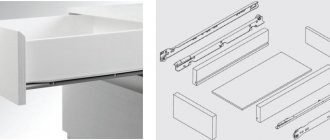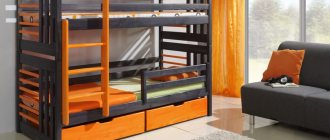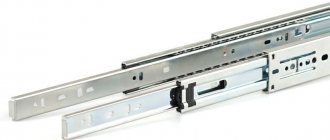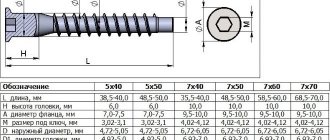Device and installation
A gas lift is a bracket that raises and lowers the door of a wall cabinet and locks it in the open position. This kitchen mechanism consists of the following elements:
- housing, with nitrogen;
- a rod moving along the body;
- bearings that ensure uniform movement of the rod;
- parts that maintain tightness: bushing, oil seal, boot, sealing element;
- fastening parts.
The rod is attached to the door using all the auxiliary elements. There are different versions. If installed incorrectly, distortions may occur. In this case, not only aesthetics are lost, but also the functional mechanism will not provide its purpose. Before installation, you need to mark the fasteners. The mechanism must match the design of the cabinet. So, if its internal space has a height of 365 mm, then the gas lift should have a length of 355 mm.
When installing a gas lift, the base of the device is fixed in the side of the cabinet in a pre-designated location. The bracket is screwed into the marked location and the elevator head is snapped into the bracket.
In some designs, the base is a plate with a hole, installed on screws in the side so that the center of the hole coincides with the applied mark. Next, the hinge head is inserted into this hole and secured. The plate must not be deformed to avoid malfunction.
Installation on the inner surface of doors is carried out in the same way. The angle of inclination of the hinge should be approximately 8 degrees. The correct direction is checked with the rod extended to its maximum.
Recommendations for long-term use of an office chair
- About once every six months you need to inspect all the furniture parts, check the tightness of the connections and whether all the nuts and bolts are tightly tightened;
- Fabric parts must be cleaned with a vacuum cleaner. If there are stains, you can use various stain removers;
- If the upholstery is made of leather, it must be wiped with a damp cloth soaked in a special solution;
- It is worth considering the maximum load of the chair used;
- There is no need to sit down suddenly on the seat to avoid breaking the crosspiece or gas lift;
If you follow the necessary recommendations, your office chair can last for many years.
Chairs on wheels are a modern invention that helps you work in comfort, move around the room and reduce stress on your back. But if used incorrectly, and especially when trying to swing on such a chair, damage may occur. The crosspiece of the chair is most often subject to deformation. In this article we will look at why this part is needed and how to properly replace it yourself.
Choosing a gas lift
When choosing a gas lift, you need to know the weight of the doors on which it will be installed. The heavier the door, the greater the holding force must be. There are mechanisms that are set to automatic mode: when the doors are open, after a certain period of time, the operation occurs and the closing begins. This is convenient when the housewife forgot to close the cabinet, or when they hang very high.
When purchasing a gas lift, you need to pay attention to the manufacturer. The best are German and Italian mechanisms. You can choose Polish options from the available assortment. Recently, Chinese enterprises have also improved their quality. Selection criteria: material of manufacture and the force applied to close the door. A high-quality gas lift will serve for a long time and flawlessly if used correctly; you can order it from the Mebrestavratsiya company.
Functional types
For each of the above types of activities, a gas lift of the appropriate type can be selected. There are several main criteria for choosing such systems.
Direction of action
In this case, direct and reverse gas lifts are distinguished. The work of the former is based on compression of the rod. By default, this element is extended to its full length. It is this type of gas lift that is used in furniture production. As for the reverse system, the rod extends from the inside.
Cylinder pressure level
Springs with a high or low degree of pressure can be installed in the design.
- For the first, a combination of a rod and a cylinder filled with inert gas is used (non-separable product). Gas displaces the rod part from the cylindrical part. As the rod deepens, the gas volume is reduced, which leads to an increase in the degree of spring pressure.
- The latter are represented by two hollow cylinders. The spring pressure in them changes in proportion to the volume of pumped gas.
It is worth noting that low pressure systems have virtually no operational restrictions. They are easy to use and maintain, starting from the stage of installation into a furniture structure (or any other).
Type of spring lock
Gas lifts with a lockable spring can be considered a separate functional type. The stop element is installed on a pressure tube or rod, which allows you to stop the progress of the structure at the right moment. In particular, this is relevant when adjusting the height of office chairs. The gas lift is fixed by means of a special button that controls the piston valve (the system is set in motion by pressing this element).
From a technical point of view, there are three methods of blocking:
- Standard (with a fairly elastic fastener). Over time, the risk of spontaneous movement of the piston increases.
- Ambivalent. When the piston is pulled out, the fixation is more rigid, which increases reliability.
- Combined. Equally rigid fixation, preventing free movement of the spring element in any direction if the lever in the structure is not pressed.
Naturally, the degree of reliability of the system affects its final cost.
Repair of gas lift for kitchen furniture
The gas lift is a sealed structure. Gas is pumped into the cylinder of the mechanism during manufacture. This device cannot be repaired, so you should not open it yourself. The entire system is under pressure. If the seal is lost, the gas lift will not cope with its functions. To avoid unpleasant phenomena, it is better to invite a specialist for repairs. A sealed system may even explode.
However, there are minor defects during operation: gas lift fastenings may become loose during operation. The doors begin to creak when opened. To eliminate the defect you need to tighten them. Another option for getting rid of an unpleasant squeak: lubricating the parts. In conclusion, it should be noted that the gas lift must be treated very carefully, since the mechanism cannot be repaired, and if it breaks down, you will have to throw out the expensive device and install a new one.
Flaws
The main disadvantages of a gas lift include its tightness - if it is discovered that the device does not hold the door, it means that the seal of the housing has been broken and the gas has escaped. Such a defect cannot be repaired - the entire lift will have to be replaced. However, with proper installation and operation, such damage should not occur, which explains the reliability and popularity of this type of fittings.
Gas lift device
A bracket used to raise or lower a drawer door and fix it in this position is called a gas lift. The gas lift mechanism for the kitchen shown in the photo includes:
- a housing filled with gas, most often nitrogen;
- rod moving in the body;
- sliding bearings ensuring uniformity and smooth movement of the rod;
- components that ensure the tightness of the structure: bushing, oil seal, boot, seal.
There are fasteners in the body and at the end of the rod. With their help, the body is attached to the inner surface of the furniture wall, and the rod is attached to the door. A different design is possible, but the principle of operation remains the same everywhere.
The main advantage of such fittings is its reliability, durability and aesthetics. These qualities explain why gas lifts for kitchens have become so popular lately. How to install it is well known to any furniture assembler. To do this you will need: a ruler, a screwdriver, a screwdriver and a drill. The gas lift lifting mechanism for the kitchen is attached using a spring bracket, which allows you to simply snap the mechanism or plates onto it, fastening to it using screws.
The upper end of the gas lift is fixed on the side wall of the inside of the cabinet at a distance of 29 mm from the bottom edge of the top shelf and 37 mm from the edge of the side wall. The length of the gas lift is determined by the dimensions of the furniture as follows: when the door is opened downwards, with the upper part reinforced as described above, the lower part is attached to the door at the following distance from its inner end:
- with an internal cabinet height of 190 mm - 50 mm;
- at a height of 264 mm - 84 mm;
- at a height of 365 mm - 128 mm.
- Thus, in the first case, the length of the entire bracket when open is 164, in the second - 244, in the third - 355 mm.
Principle of operation
The operating principle of a gas lift for office chairs is simple. A rod with a piston moves along a cylinder located in a body made of metal. There are two containers in the pipe, and between them there is a valve. It can be in a closed or open position, when gas moves from one cavity to another along the passage channel. When the seat is positioned at the bottom, the piston is located at the top. When the lever is pressed, gas moves from one container to another. In this case, the piston moves down and the structure rises.
To fix the seat at the required height, the lever is lowered, the valve closes, and the lifting of the chair stops. To lower, the lever is pressed, and the structure begins to lower under the weight of a person. The gas piston allows the chair to be adjusted in height and rotated around its own axis. A special spring significantly reduces the load on the spine during a sharp landing, thereby preventing many diseases.
Cautions
Installing kitchen furniture fittings is a responsible process. It's not just that improperly installed lifts will cause doors to open and close incorrectly and unevenly, kitchen cabinets store fragile and expensive items.
Incorrectly assembled furniture can lead to broken dishes and injury. A person unfamiliar with this work and without the necessary tools will have a hard time. That is why, to install and repair furniture in the kitchen, it is always better to use the services of specialists who have the necessary knowledge and skills in this field and own all the necessary tools.
Vertical lifting mechanism
Vertical lift of the cabinet door
There is only one drawback of folding mechanisms - if you are below average height, you will have to, if not jump, then constantly stretch out in order to “hook” the high-thrown door and close it. Well, European manufacturers of premium-segment fittings have also provided for this: lifting the facade vertically along the body will be more convenient and practical for you.
Types of gas lifts
Let us highlight three main characteristics by which gas elevators can be classified:
Depending on the power load
The lifting force of gas shock absorbers is determined in Newtons, which you can see by the markings on the gas lift body. In order for this value to be understandable and tangible, the following correspondence is given: to lift a facade weighing 1 kg, a lifting force of 10 Newtons will be required.
It turns out that if the lift says 60 N, then it will lift the facade 6 kg, and even in one copy. But the reality turned out to be different, as we will show in our video at the bottom of the article.
For kitchen furniture you can find lifts from 50N to 140N, although the upper and lower load limits are sold much less frequently due to low demand.
Sellers and manufacturers provide interesting plates on the selection and calculation of gas lifts , we will provide them for you.
Selection of gas lift depending on the size of the facade
The first table, in fact, there are a lot of variations of such tables, shows how you can choose a gas elevator depending on the width and height of the facade.
In our version, the width of the facade is 800 mm and the height is 400 mm. It turns out that we need to install two gas lifts at 80 N. We installed two gas lifts at 60 N, and there were no problems with fixing the facade in the upper position.
In the second cabinet of the same size in height and width, we decided to install a shelf and reduced the size of the section in height so that only a mini gas lift could be installed. To raise the façade, we also used two 60N gas lifts, but only of a smaller size. But in the end, the power of the gas lifts was not enough and the facade lowered and did not lock in the upper position.
Here the way out of this situation is obvious - to cut the shelf in depth so that it does not interfere with the installation of a standard-sized gas lift, or to buy much more powerful mini gas lifts, if there are any. And why this happens, perhaps the formula for calculating the force of a gas elevator will give us the answer.
Gas elevator force calculation
For our cabinet, the gas lift calculation will be as follows:
With standard gas lifts:
F1 = 3.5*0.2/2*0.08+15%=4.4+15%=4.4+0.66=5.06 kg
With mini gas lifts:
F1 = 3.5*0.2/2*0.05+15%=7+15%=7+1.05=8.05 kg
So, from the calculation we get that for a cabinet 800 mm wide and 400 mm high with a facade made of MDF 16 mm thick and weighing about 3.5 kg, gas lifts with a lifting force of about 50 N (5.06 kg * 9.8 m/s2) are suitable = 49.6 N), we have 60 N, which exceeds the calculated one.
In the second option, the value of L - the distance from the center of the axis to the gas lift attachment point is equal to 0.05 m and with this value we need gas lifts with a lifting force of about 80 N (8.05 kg * 9.8 m/s2 = 78.9 N), we We used mini gas lifts 60 N and they really no longer fix the façade in the upper position.
The conclusion is that both schemes for selecting gas lifts are suitable, although for mini gas lifts it may be necessary to shift towards gas lifts with a higher power load.
What will happen if you install gas lifts of obviously higher power?
Yes, but really, what will happen? We were once visiting a friend and noticed that the facades on the gas lifts were skewed.
It turned out that the owner of the kitchen bought gas lifts with greater power than previously, and so much more that it became difficult to open the facades. I found a way out: I left one gas lift per cabinet, everything would have been fine, but the facades began to warp. In addition, the counter strips from the hinges began to gradually break out of the horizontal lines.
The conclusion is obvious - carefully select gas lifts according to the power load so that the facades do not fall down when opening or, on the contrary, open with difficulty.
Gas lift dimensions
As you already understood from the previous section, there are standard size gas lifts, and there are mini gas lifts , which are used if our cabinet is small in height. But the concept of small also has its limit - at least 170 mm on the inside - this is the height distance between the upper and lower horizontals of the cabinet.
Gas lifts by type of action
, direct and reverse gas lifts can be distinguished .
Direct action is the type of lifting of the facade that we are used to, that is, up. The reverse action is that the facade opens downwards, that is, according to the bar principle. Take a closer look at the photo of this gas lift and you will see its difference from an ordinary gas lift.
Procedure
Precise adherence to the procedure is the basis for proper installation. By following these steps step by step, you will be able to avoid common mistakes that can lead to damage to the product and shorten its service life.
Preparation and assembly of MDF parts
A large number of bed parts are made of MDF. When starting installation, all elements are freed from the packaging film and inspected for damage. If at least one element has defects, replacement is required. A damaged bed frame will not be secure. The parts are laid out at the installation site so that the side with holes for fasteners is on top.
Installation of box and base
The main parts of the bed are the box and the base. First, the perimeter of the structure is assembled, which consists of three walls and a head back. To do this you need:
- connect the walls and the head back to each other using fixing elements;
- a base is placed on the constructed frame, which is usually made using wood and a metal frame;
- To securely fix all components, tighten the screws with a screwdriver.
In some types of beds, longitudinal strength elements may be provided. In particular, solid longitudinal ties, brackets and corners, fixed to the structure with screws, are common
Installing Corner Ties
The purpose of corner ties is to impart reliability to the assembled structure. The screed consists of several elements:
- a corner in the form of a metal plate bent in the central part at a right angle;
- bolts for fixing the plate to the frame;
- threaded bushings.
To connect the two walls of the bed with a corner tie, the plate is placed on the inside at their junction. Then the bushings are inserted and the bolts are tightened first on one wall, and then the connections are aligned and the fasteners are fixed on the adjacent wall. If desired, it is possible to replace the standard model of corner tie with a modern version, for example, confirmat or minifix, which are distinguished by more compact dimensions.
How to install the lifting mechanism
- Secure the furniture frame to the lifting mechanism. It is recommended to use screws for this. Before final fixation of the fasteners, it is necessary to level the gaps between the base and the frame.
- Determine the appropriate level of force to operate the mechanism. As a rule, this information is indicated in the attached documentation.
- Install the structure into the lifting mechanism with the cylinder facing up, using nuts with a locking ring and fluoroplastic washers.
- Tighten the fixing nuts to the limit, then loosen the fastening slightly, leaving minimal play. After this, you should check the functioning of the lifting mechanism by lowering and raising the structure several times.
Installation of the traverse
The traverse is a special element that performs the function of a screed. Using a traverse, the lower part of the bed frame is fixed. The element is placed along the structure parallel to the longitudinal tension parts. The use of a traverse helps strengthen the structure, ensures stability and durability, and also makes it possible to securely fasten small side elements that most often fail.
How to install a gas lift on a kitchen cabinet?
Gas lifts are shock-absorbing mechanisms designed for horizontal opening doors. The mechanism refers to brackets. The main essence of the gas lift is depreciation when opening and closing doors and holding them.
The mechanism helps you open and close cabinets effortlessly, and open the doors completely to see what is inside the cabinet.
The gas lift is completely sealed. Nitrogen is pumped during manufacture, so if it breaks during operation it cannot be repaired.
The list of advantages of an elevator can be compiled from the following properties:
- self-regulation of smooth running;
- reliable fixation when open;
- frictional and automatic opening;
- fastening to any furniture material;
- The door opens even without a handle.
Spring mechanism Lift Junior
Spring lifting mechanism for narrow facades
Rigid mechanics of the “don’t pinch your fingers while installing” category. Provides opening of the mezzanine door by approximately 90 degrees, holds the “weight” of up to 4 kg. Of course, we can’t talk about smooth running and silent closing. But it has an undoubted advantage - the mechanism is low, it can be installed in the narrowest cabinet, about 140-150 mm in height (internal size). In this regard, the Lift Junior spring lifting mechanism simply has no analogues. There is one more feature - installation of additional hinges on the folding facade is not required.
Gas elevator design
It is a structure consisting of the following components made of plastic and metal:
- Sleeve.
- Elevator cone.
- External and internal cavities.
- Lifting rod.
- Landing, outer and inner cones.
- Button.
- Sealing element.
- Gas valve.
- Bearing.
- Gas bypass channel.
Common breakdowns
As noted above, an office chair is a rather complex device and any of its structural elements can fail.
Damage to the cross
The problem with this element may be destruction at the junction of the beams. The material from which the cross is made is important here.
As a rule, the base is a hollow structure into which a polypropylene pipe of suitable size and cross-section can be inserted. It, in turn, must be rigidly fixed to the base and the damaged beam.
In order to dismantle the crosspiece of an office chair, you need:
- Remove the rollers. As a rule, they do not have a rigid fixation and are quite simply removed from the mounting sockets. To illustrate the process, it is recommended to watch the video:
- Dismantle the piastra. Fastening to the seat is done “on a cone”. Disconnection from the gas elevator is carried out by tapping on the attachment point. The correct process for disassembling an office chair is shown in the video:
- Remove the retaining clip located in the recess on the top of the hydraulic lift.
- Knock out the gas lift to repair or replace the five-arm.
The process technology and dismantling device are shown in the video:
Destruction of the swing mechanism
If the chair does not hold the “horizon”, then the problem is most likely in the destruction of the swing mechanism.
Fastening to the seat is done with four screws using a shaped screwdriver. The element is dismantled as follows:
- DIY feeder chair
- The bolts that secure the rocking mechanism from the seat are unscrewed
- The gas lift is knocked out of the device mount.
This element is made of metal.
It should be noted that most chairs originating from the Middle Kingdom are not suitable for domestic spare parts. This concerns, first of all, the swing mechanisms (size discrepancy).
- Chinese mechanisms: 200 x 200 mm.
- Domestic: 200 x 150 mm.
In order not to re-drill holes when replacing an element, we suggest using adapter plates. How it looks assembled can be seen in the figure below.
Air chuck failure
The pneumatic cartridge of the chair is a two-chamber structure filled with air. When you press the adjustment lever, the valve stops the flow of air between the chambers.
If, when pressing on the valve, the gas lift rod does not extend, it means that the integrity of the piston, seal, etc. is compromised.
The dismantling process is described above. To clarify the process, watch the video about replacing the gas cartridge on office chairs:
A fairly common cause of gas lift failure is the bending of the adjustment lever, which does not allow pressing on the cartridge valve. In this case, the repair can be easily carried out independently: you need to bend the lever to its original state.
How to properly install a gas lift on a kitchen cabinet?
At the beginning of work, you need to select a tool and make markings, purchase gas lifts and components. Gas lifts are characterized by different parameters and the force at which the spring is compressed. The device must match the size of the furniture. Typically, the dimensions of furniture are standard and there are three main options for gas lifts in size. You need to know the maximum extension of the rod and the length of the folded mechanism.
The compression force is needed when calculating the design for doors of different weights, taking into account the entire coating and fittings. The amount of compression of the spring is standardized and indicated in the technical data sheet of the mechanism, measured in newtons and can be 60, 80, 100 and up to 140 N. Based on the weight of the door, the gas lift is calculated based on a kilogram of door mass per 10 newtons of compression force.
There are many ways to attach. Flat platforms are often used, mounted on the sides of the cabinet with screws and self-tapping screws. Screw-in holders are used for wooden furniture.
What tools will be needed during installation?
You need a set of tools - one is not enough. If you want to install it yourself, you will need:
- Meter, ruler or tape measure.
- Hammer and pliers.
- Drill (preferably electric).
- Screwdriver or screwdriver (the latter is preferable).
Step 1. Marking before installation
Before installing the device, markings are made in the cabinet niche and calculations necessary for installation are made. The centers of the mounting points are also marked on both sides of the niche and on the door.
Step 2. Installation work
Installing a gas lift on a kitchen cabinet is carried out as follows:
1. First, the bases are fixed to the sides of the cabinet in the places marked earlier.
2. Plates and brackets with springs are installed. The bracket is screwed in and the gas lift head snaps directly onto it.
3. The center of the fastening must coincide with the marked one; the base is fastened in different versions with 3 or 4 screws or self-tapping screws. The head of the structure is fixed in the holes.
Important! If the plate is bent, the elevator does not work.
4. The same steps are taken to secure it to the furniture door. The hinge angle should be 8 degrees.
Gas lift installation diagram
5 installation tips
In connection with mounting the device yourself, we can provide some useful tips:
- The mechanism must be fixed to the sides of the niche - otherwise the fastening will be skewed.
- The door in the cabinet must be firmly secured with two additional furniture hinges.
- It is better to choose elevators with a force of up to 80 Newtons; doors of greater mass are not available in practice.
- Door fittings must be installed before gas lifts are installed.
- When installing a kitchen cabinet, it should not hang on the wall.
The upper cabinets are equipped with a gas lift.
Gas lifts are very convenient and expand the functionality of cabinets and other furniture. The low price and the ability to buy and install them yourself from the facade give them advantages over other structures. The disadvantage of the device is the inability to repair an already installed gas lift for the kitchen. There are many videos on the Internet and complete instructions on how to attach the device. You can place it on a cabinet made of any material.
The main purpose
Initially, the gas elevator was actively used in automobile production. Using this technology, hoods and trunks are held in place during operation of the compartments they cover. Lifts can act as an additional structural support, not only holding the barrier, but also protecting it from accidental damage.
They have also found application in the following areas:
- construction works;
- production of medical equipment;
- printing;
- pneumatic weapon systems;
- aerospace industry, etc.
Gas lifts came into furniture assembly a little later. Most often they are used to create kitchen shelves. This technical solution not only increases the comfort of use, but also saves the space occupied by the furniture set. Also, a gas elevator is ideal for ensuring the operation of office chairs, sofas with folding structures, wardrobe beds and other “transformers”. For each product, a specific functional and dimensional type of gas lift is selected.
What is a gas lift and how does it work?
A gas lift for a kitchen façade is a lift consisting of a piston and a cylinder. Its main purpose is to lift and hold doors that open upward at a 90-degree angle. The cylinder contains an inert gas, which creates a shock-absorbing effect, that is, preventing the spring in the lift from sharply compressing and decompressing.
Thanks to this, the doors open smoothly and clearly, eliminating their backlash. As a result, kitchen cabinets will last for a long time and look perfect at the same time. And you can forget about skewed facades (a problem that everyone had to face before) forever. And what’s most convenient is that there is no need to constantly hold it with your hand when opening the cabinet.
Precautionary measures
Repairing the product should be as careful as possible, because some of the expensive parts are protected by a thick layer of lubricant.
Replacing the crosspiece on an office chair while observing safety precautions will help the technician significantly reduce the repair time. Basic recommendations:
It is worth putting on fabric gloves with rubber coating on your hands and a protective mask on your face. The surface of the floor or table where repairs will be carried out must be covered with old newspaper or oilcloth. It is important to fix broken furniture firmly so that it does not wobble during repairs. A child or a fragile girl can even become an assistant. Knock out the steel bearing as carefully as possible so as not to damage its complex structure. It is safer to remove the cross from the chair using a rubber or wooden hammer
The vapors of the penetrating liquid are quite dangerous to human health. If it is used, the room must be ventilated for 20-30 minutes.
In order for the chair to last as long as possible after changing parts, it must be looked after regularly.
It is important to check the tightness of connections every six months, inspect bolts and nuts. It is imperative to take into account the maximum load of the furniture, do not sit on it abruptly to avoid breaking its elements
To summarize, we can say that removing the cross from a computer office chair is quite simple. To carry out the work, you only need a skilled man and simple available tools. Self-repair will not take much time, but will help extend the life of the product and avoid large expenses on new furniture.
Gas lifts for the kitchen - types and features
The design of such systems can be different, depending on their scope of application. Depending on the direction of action, gas lifts can be:
- Direct acting (i.e. compressing the rod). Initially, the rod in such systems is extended to its full length. This system has found wide application in the furniture industry.
- Reverse action. The rod, initially recessed, extends during use; it extends.
Based on the level of pressure in the cylinder, these devices are divided into:
- High pressure. The design of such lifts includes two main elements - a rod and a cylinder, inside of which there is an inert gas. When the rod is immersed in the cylinder, the volume of the latter decreases and the pressure increases.
- Low pressure. It consists of two hollow cylinders containing compressed gas. When a gas is compressed, its volume increases and the pressure level inside the spring increases. The lifespan of a gas lift for a kitchen cabinet of this type is practically unlimited. In addition, their maintenance and adjustment can even be carried out on their own.
Why might a chair explode?
Dangerous part
Of course, there are no explosives in the office chair. And only one part can explode, which, in fact, distinguishes such a chair from an ordinary chair - this is a gas lift (gas lift, pneumatic lift)
allowing you to adjust its height.
A gas lift is essentially a spring, the elastic element of which is the gas enclosed in the device. The gas is under high pressure (at least 30 atmospheres).
The gas in the pneumatic lift is located in two cavities, separated by a piston with a rod attached to the lower part of the gas lift. The piston is located inside the spindle - the moving part of the gas lift. When the chair is in its lowest position, the piston is at the top of the spindle. When we press the lever of the chair, it presses the button. The button opens the valve through which gas passes from the lower cavity (under the piston) to an area of lower pressure - above the piston. Increasing gas pressure presses on the piston, which causes the spindle (and with it the seat of the chair) to rise.
However, as soon as we sit down on a chair, under the influence of body weight (usually at least 40 kg), the chair lowers as the gas returns to the lower cavity - under the piston.
Please note: the piston rod rests on a bearing, allowing the chair to rotate freely
How does an explosion occur?
A gas lift explosion can occur for only one reason - when the cylinder depressurizes. This happens in the following cases:
1. Spindle housing rupture.
If the metal walls or plastic elements of the spindle cannot withstand a sharp increase in pressure (for example, if you suddenly sit down in a chair), then the pressure above the piston will drop sharply. As a result, the pressure under the piston will cause the spindle to shoot upward out of the gas lift housing with great force. A broken gas valve can lead to this scenario.
2. Gas lift rupture along the weld seam.
In the event of a sudden rupture of the gas lift along the weld seam (in the lower part of the device), high gas pressure can throw the metal parts of the device with great force.











